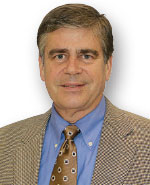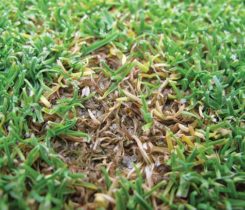Anthracnose: A chronic problem
 An article appeared in the June issue of Golfdom entitled, “The 2015 Fungicide Survey.” The survey asked superintendents, “What is the most difficult disease to control?” The answer by far was anthracnose.
An article appeared in the June issue of Golfdom entitled, “The 2015 Fungicide Survey.” The survey asked superintendents, “What is the most difficult disease to control?” The answer by far was anthracnose.
It isn’t a surprise to me that anthracnose is, across the board, the most difficult disease to control because it is so closely tied to stress, whether environmental or management. Anthracnose (pathogen: Colletotrichum cereale, or back in the day what I knew as C. graminicola) first came to the attention of golf course superintendents back in the 1970s as a foliar disease on Poa annua fairways.
At the time, anthracnose was a polarizing topic in the golf course industry. Joseph M. Vargas Jr., Ph.D., was reporting that the major cause of Poa annua decline in the summer was caused by anthracnose. An opposing view was that anthracnose was a saprophyte (a fungus that colonizes dead tissue), and the real cause of Poa annua decline was high summertime temperatures. The opposing views of anthracnose split golf course superintendents into two groups: those who would spray and maintain Poa annua and those who would try to kill Poa. I think the ability to control anthracnose and reduce the severity of summertime Poa decline illuminated to many in the golf industry the philosophy that Poa could be managed as a desirable turf and not just something to kill.
From the 1980s on, the most serious anthracnose disease has been basal rot. Basal rot anthracnose, as the name implies, attacks the lower sheaths of the turf plant, including the crown. The pathogen produces small black bumps, known as acervuli. It was originally thought the basal rot anthracnose did not produce setae — hair-like appendages that protrude from acervuli — but under severe infection setae do appear. A serious problem on Poa annua, it also occurs on creeping bentgrass greens primarily in the mid-Atlantic and southeastern United States.
Anthracnose is so difficult to control because it can occur under a wide range of environmental conditions. Basal rot anthracnose can occur from early spring through late fall, although it often seems like it is there year-round. A key management practice in reducing the likelihood of anthracnose, or at least an early arrival of anthracnose in the spring, is to clean up infected turf areas from the previous fall. Make sure your greens are healthy prior to winter and that diseased areas have recovered. If this is not done you are almost guaranteed an early arrival of anthracnose in the spring.
The wide range of conditions under which anthracnose can occur makes it difficult to predict. Several years ago I was playing a links course in England with a colleague. It was November, and as I walked up onto the Poa annua greens I noticed a characteristic of anthracnose. Upon closer examination I confirmed that the orangish-yellow areas were anthracnose. I asked my colleague how this could be, anthracnose on greens maintained at 6 millimeters (~0.25 inches) in November. His reply was, “It’s been wet.”
June and July in the Great Lakes region this year have been nothing short of depressing. It seems like it has rained every day. Even with what I would consider moderate temperatures in Ohio, anthracnose has been active. Too much of anything can cause stress. So it should come as no surprise that anthracnose has appeared where too much water has accumulated.
Because anthracnose can occur under stress, management practices become extremely important in enhancing or reducing the likelihood or severity of the disease. As most superintendents know, intensive management (such as lower heights and fertility) can enhance the disease. Successful anthracnose management programs have been developed from research at several universities, including Rutgers. A key to having success with these programs is to adhere to them.









